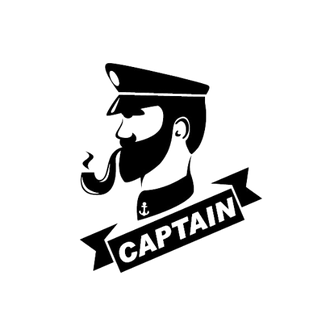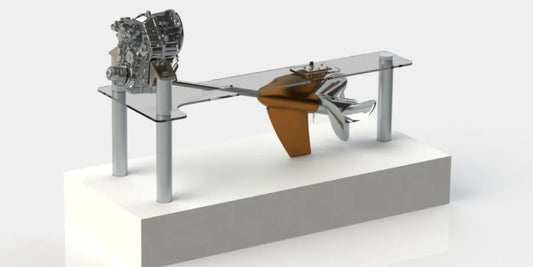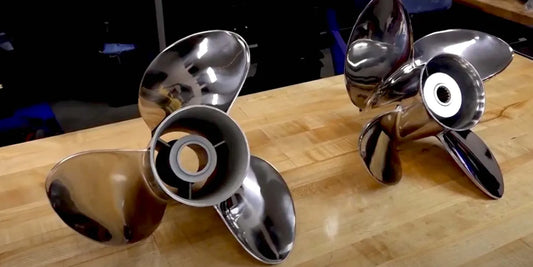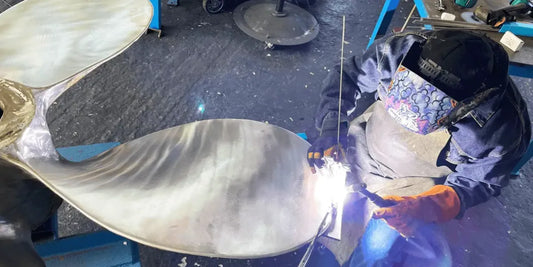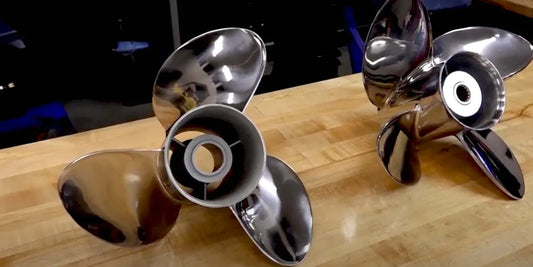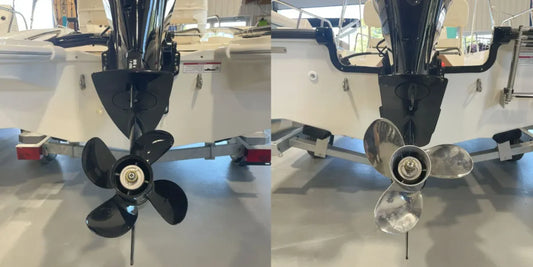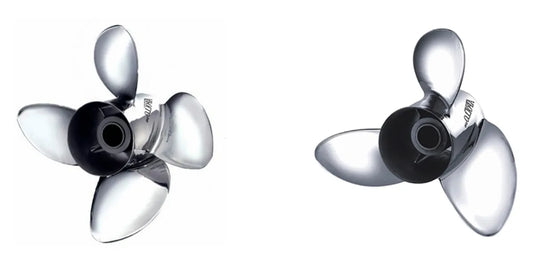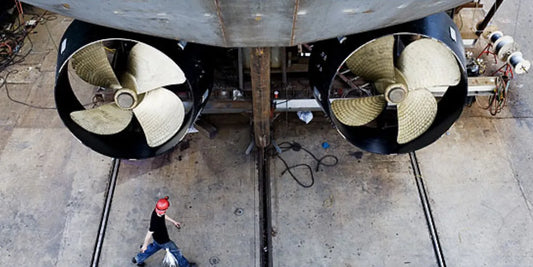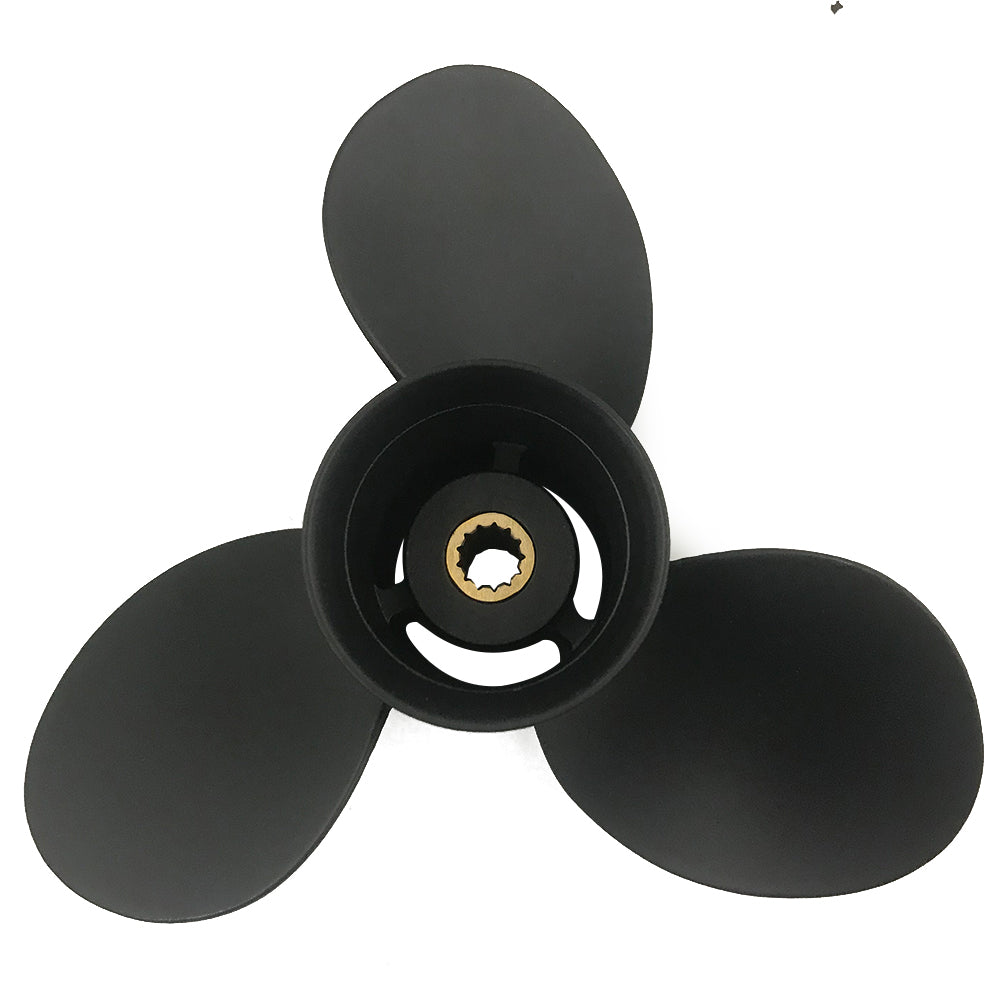Generally, a boat’s performance depends on several intricate components working in perfect sync, and the propeller stands on top of it all. Yet, a spun prop might be the thing that locks the best-maintained boat. The problem manifests with a sudden loss of speed, poor acceleration, or an engine revving up with no actual movement. So, what is a spun prop, and how does it affect the overall working of your boat? Today, we'll dissect the dynamics of a spun prop; give insights as to how to tell if the propeller is working against you with the means to solve this problem, and get your boat cruising smoothly once again. This knowledge will help you maintain efficiency and save you from expensive repairs!
What Causes a Spun Prop?

How does a rubber hub contribute to a spun prop?
Rubber hubs in propellers perform an essential function as shock absorbers, to safeguard the drive train against sudden impacts and excessive torque. The hub is inside the propeller and pressed to the propeller hub with special machinery. Wear and aging of the rubber material diminish its ability to hold firmly onto the propeller core. The failure of a rubber hub causes the engine power to no longer be put on the propeller blades, which is called a "spun-prop."
Generally, this happens when very high torque is applied, such as under hard acceleration or when an underwater object is hit. The separation inside the hub causes loss of synchronization between the engine and the prop; the symptoms include loss of speed, loss of thrust, and a rise in engine RPM without the boat moving. Therefore, inspection and maintenance of the rubber hub are imperative to avoid a surprise failure and keep things moving smoothly.
What are the common signs that indicate a hub has spun?
When a hub has spun, the significant tell-tale sign is the spool loss in propulsion. The engine is known to rev up considerably higher than usual. Still, the boat will not speed up accordingly, suggesting a scenic disconnect between the engine's work and the propeller's movements. This phenomenon occurs because the rubber inside the propeller is separated from the metal core, and it cannot effectively transfer torque. In simple terms, some call it the engine "sliding" on and off or making a gurgling sound, which translates to the engine putting more effort in but achieving less thrust.
They may be seen as having reduced overall performance. For instance, slower speeds despite high throttle inputs can be noticed. Alongside that, there may also be an inability to put the boat into plane or maintain proper planing. At high loads, like towing or choppy waters, the problem appears more because the propeller remains inefficient under stress. After symptoms have shown, a dead giveaway would be to inspect for visible signs of damage to the rubbers, causing excessive wear or melting.
The condition of a spun hub and its adverse effects will progressively deteriorate if left unattended, leading to several unexpected malfunctions while underway, often resulting in being stranded. To conclude such a problem, operators will usually perform a special test whereby the metal core and the propeller are marked, and the engine is run at load; after this use, it is then checked whether the two marks have shifted and gone out of alignment. Proper upkeep and heeding of such signs will save one an awful lot of trouble and ensure reliable performance on water.
Can a spun prop affect boat speed and handling?
Yes, indeed, a spun prop has a profound effect on boat speed and handling. When the rubber hub inside the propeller is compromised, the ability to transmit engine power effectively to the propeller blades suffers. A decrease in the boat's top speed and acceleration is often felt because, in such an efficient condition, the propeller is unable to generate as much thrust. Erratic handling is another problem the boat faces, possibly difficulty maintaining a straight course or remaining responsive in steering maneuvers.
Sometimes, cases have been reported whereby the engine revs high without a corresponding increase in speed; this condition is called "prop slip." This inefficiency eventually compromises the boat's performance and increases fuel consumption because the engine needs to make up for the loss in propulsion. Thus, promptly addressing a spun prop is paramount to ensure good handling, speed, fuel consumption, and, above all, safety on the water. Good practices of inspecting and replacing the damaged propeller when found can help curb these performance issues.
How to Fix a Spun Prop?

What tools do you need to fix a spun prop?
A spun prop must be repaired using specific materials and tools for easy and effective repair. The following tools are needed:
Propeller Wrench: This is a special-purpose wrench used to remove the propeller nut safely without damaging it.
Needle-Nose or Locking Pliers: Handy when holding small parts like cotter pins.
Replacement Hub Kit: Consisting of a new hub, installation materials, and instructions for the installation of the hub. Make sure this is compatible with your propeller.
Rubber Mallet: Used to gently loosen or secure the propeller without damaging it.
Marine Grease: Used to avoid corrosion and ease the reinstallation of the propeller.
Propeller Puller (optional): Needed in cases where the propeller is tightly wedged in.
Torque Wrench: This tool tightens the propeller nut to the exact torque specification provided by the manufacturer.
Clean Towels or Rags: Use these to remove debris, grease, or water during the repair procedure.
If you have the tools, you can handle any problem with a spun prop promptly and safely. The proper equipment will go a long way toward restoring boat performance and maintaining it for a long time.
When should you replace the propeller hub?
Replacing the propeller hub is necessary whenever high wear or damage exposes performance or safety issues. Some telltale signs of wear can be a decreased boat speed while keeping engines running normally, strange vibrations seemingly coming from nowhere, or troubles with acceleration. Very often, the cause can be the rubber insert of the hub getting worn, which causes slipping, which is referred to as a "spun hub." Suppose any crack or visual sign of deterioration in the hub exists. In that case, it must be replaced immediately to prevent further damage to the propeller or the engine drive shaft.
Thorough inspection is necessary to discover any early indication of a problem. On average, a propeller hub must be replaced every 3-5 years, depending upon usage and environmental factors (such as exposure to debris or corrosive water conditions). Regular upkeep and careful operation (avoid striking submerged objects) will prolong the hub's life span, thereby maintaining reliable operation on the water.
Can a prop shop help with a spun prop repair?
Yes, the prop shop often helps save a spun prop. A spun prop usually happens when the bond between the propeller's hub and the outer blade housing fails, allowing any slipping and loss of propulsion. A propeller shop has the tools and know-how to diagnose the problem and suggest the best solution.
The repair procedure could involve repressing or replacing the hub, depending on how bad things are. The tools used in these operations are special, which makes for the good seating of the new hub when aligned to get optimum performance. Many reputable propeller repair shops also carry OEM parts to ensure compatibility and durability. Properly repairing or maintaining a spun propeller will restore the prop's efficiency, lengthen its service life, and protect your engine from further damage. For those who face constant hub failures, the prop shop can advise upgrades or alternate materials that better fit their application, such as stainless steel props for harsh environments or aluminum for general-purpose use.
What is a Propeller Hub and How Does it Work?

What is the purpose of a propeller hub?
Having the central element of the propeller assembly connect the propeller blades to the engine or motor of a vessel produces stability and functionality in propulsion systems. The hub is the key member of a propeller assembly because the hub divides the rotational force given by the engine evenly to all blades. Without the hub, the blades could not work as one, and the energy provided by the engine would not translate into usable thrust.
The hub's other function is to help absorb and mitigate vibrations that travel from the engine to the propeller. Most modern propeller hubs use rubber bushings or a similar method of dampening shock waves generated by sudden impacts or engine speed changes. This will ensure the protection of the engine and propeller and smooth the operation.
In the event of a collision or excessive load, the hub can help avoid damage from uncontrolled forces. For example, some propeller hubs are equipped with a fail-safe mechanism—for example, shear pins or rubber inserts—that allows the hub to fail under extreme stress in a controlled way rather than passing all that force to the engine or other vital components. Combining functionality, safety, and performance, the propeller hub thus makes for a crucial link in the watercraft propulsion systems.
How does a prop and hub system function together?
The propeller and hub's thrust-generating mechanism is designed to propel the vessel conventionally by efficiently harnessing engine power. The engine generates a rotating torque, which is then transmitted by the hub, which grips the propeller blades rigidly. As the engine rotates, the hub drives the blades through rotational motion to thrust them against the water. The system tries to block drag through a streamlined channel and, in return, gives maximum advantage in propulsion.
Modern designs with materials and engineering features aim to reduce vibration and enhance performance. For example, rubber inserts on the hub absorb shocks and vibrations to allow smooth operations while protecting the driveline from deterioration. To attain the best possible performance, the propellers have to be sized and pitched correctly to go hand in hand with the engine parameters and the specifications for which the vessel will be used, be it speed, towing, or fuel consumption. Prop and hub together form a well-balanced system for dependable safety and efficient propulsion in marine operations.
What should you know about different types of propeller hubs?
Applications vary between propeller hubs due to their design, each with unique features that fulfill different marine requirements. Common variations include:
Fixed Hubs: Similar to the traditional concept of fixed propeller hubs, the fixed hub is cast as one piece with the propeller and is hence brought into service in most cases where reliability is required and a standard propeller application is contemplated. They are an excellent choice for vessels engaged in steady work and in environments where some degree of sophisticated flexibility is not required.
Rubber Hubs: A rubber hub consists of an inner rubber sleeve that isolates vibration between the engine and the transmission. This type of system also realizes benefits in reduced noise and shock transmitted during a sudden change in engine speed, thus further protecting the mating components from unnecessary wear.
Modular Hubs: With this system, the hub is independent of the propeller blade, separating the two to allow for replacement and modification. They are most often found in high-performance, specialty, or development settings, having prestige, granting versatility such that vessels can be supported in different operational requirements without a complete prop replacement.
Flo-Torq or Cushioned Hubs: Introduced with cushioning technology capable of handling engines of higher torque, these hubs also safeguard vital components from damage from sudden jolts or impacts. They find application where vessels require utmost durability, high precision, and power in harsh working conditions.
Spline Hubs: Spline hubs provide a splined shaft mounting and, therefore, a more secure and quicker way of transmitting power from the engine. Commonly fitted in larger vessels, they secure robust transmission of heavy loads.
Making the distinction between hub types allows the user to choose according to the vessel's performance requirements, operating environment, and maintenance considerations. Using the right hub type will go a long way toward efficient marine propulsion and enhanced hub and propeller system life.
Why Carry a Spare Prop and Hub Kit?

What benefits does a spare prop offer for boating?
Taking along a spare propeller goes a long way in ensuring safety, reliability, and efficiency during a boat trip. Accidental damage to the propeller may be inflicted by anything from being bent due to underwater debris or hitting a rock to getting lost while trying to avoid conflicts with shallow surfaces. With a spare prop, boaters can quickly swap out the damaged one and carry on with their trip, thus warding off the risk of being stranded in a remote or inaccessible location.
Another reason for spare props is to retain optimal performance. Using a damaged prop or one that is unsuitable for the condition translates to decreased fuel economy, slower speeds, and much strain on the engine, which may cause long-term damage to the propulsion system. As a result, a backup prop assures the boat runs efficiently in any condition.
Those who often boat in different conditions, such as shallow waters or areas with frequent obstructions, benefit from the flexibility that a spare propeller provides. With the right tools and know-how, replacing a propeller becomes a relatively simple task, enhancing preparedness and peace of mind.
How do you choose the right spare prop and hub kit?
Choosing which spare prop and hub kit to buy requires considering the key parameters for compatibility and performance. The prop size and pitch must be directly matched to the engine and operating conditions of the particular boat. The prop size is the circle's diameter that the blade tips outline, while the pitch is the distance forward in one full rotation that the prop thrusts. The best combination will result in better speed and fuel economy.
Another selection criterion is the basic material. Aluminum is a good choice because it is lightweight, low-priced, and suitable for general-purpose applications. At the same time, stainless steel stands for durability and good performance at high speeds. Also, check for hub kit compatibility with your engine model since hubs establish the connections between the prop and the drive shaft.
Your style of boating is yet another primary consideration. For example, a prop that is more durable and resistant to low pitch might work better for you if you are often out in shallow water or water with a lot of debris. Finally, one must check the boat engine's manual against any new replacement or spare part to confirm that it meets the manufacturer's specifications. This way, with the help of the guidelines, one can confidently select a spare prop and hub kit that suits their needs regarding reliability and ensuring safety in the water.
What should you consider when storing a spare prop?
Extra care and preparation must be applied when storing a spare prop to maintain its long life and to keep it ready for service when required. First, consider the storage conditions. The prop should be kept in a clean, dry space sheltered from moisture so that it does not rust if it is a metal prop. Avoid storing the prop where temperatures fluctuate or humidity levels rise too high, as these could harm the material. For some added measure, consider covering the prop with a cloth made of a soft, non-abrasive material or a protective case to keep away dirt and dust, so no accidental scrapes occur.
Additionally, the prop should be inspected for damage or wear before storing it. Check for dents, irregularities, and cracks. An unbalanced prop or one with severely worn blades should not be stored, as it will become unserviceable. If there are moving parts or components, such as hubs, they should be lubricated to keep them from seizing up in later years.
Finally, familiarize yourself with storing the spare prop to ensure bad weather does not catch you unaware. Label and sort spare props for ease of access and identification when required. They are best kept alongside the necessary tools, spare hub kits, and fasteners for a brief replacement time. Applying these vital yet straightforward considerations will give you the best assurance of a long life and guaranteed efficiency for your spare prop so that you do not find yourself unprepared in an unforeseen circumstance on the water.
How Does a Spun Prop Affect Boat Performance?

What happens to RPMs when a prop spins?
With the propeller spinning, one of the distinct signs is that the revolutions per minute (RPM) rise significantly. From my experience, this happens because the propeller hub loses its grip, and the blade cannot perform the thrust that will propel the boat. Instead, either the engine applies torque to counter this load, or the load from the blade becomes less than the engine keeps loading, and RPMs rise, but the expected acceleration of the boat is missing. That mismatch between engine effort and boat movement guides one to confirm that the prop may be spun.
Thus far, I have observed that the boat has difficulty pinning at this moment, and general handling becomes slow or erratic. Lack of power prevents one from holding a consistent speed, especially at rattling throttle levels. So, check the RPM gauge, as that is likely to climb up quickly once with a suspected spun prop, which, without a corresponding speed increment, is almost conclusive.
From a practical standpoint, you want to attend to the spun prop as quickly as possible to spare the engine from further stress and damage. Changing the prop hub immediately would restore performance, or a spare prop would save the job from extended downtime. Identifying these signs will ensure that your boat runs efficiently and safely, thus saving you precious time and energy once on the water.
How can a spun prop impact fuel efficiency?
A spun prop considerably affects fuel efficiency, which I have witnessed from my experience. When the hub is damaged and loses its grip with a propeller, slippage occurs when load is applied. This causes the engine power not to be fully transferred to the water by the boat through the propeller; hence, the increased RPM without a commensurate thrust. It essentially means that the engine does extra work, consuming more fuel than usual for a certain level of performance, many times, for even less.
From what I have seen, during towing or running against strong currents, where the required speed and control must be exact, such inefficiency due to a spun prop is glaring and obvious. It causes a major petrol-guzzling situation; it also stresses the engine, which might cause further escalation of the problem with time. Immediate attention to a spun prop, such as replacing the damaged hub or fitting a spare prop, will restore optimum fuel efficiency and prevent runaway repair and upkeep costs.
What are the long-term effects of using a spun prop?
Long-term use of a spun prop has dire effects on its original performance and life, spanning the engine-propulsion system of a boat. From my experience, when we keep running the ship with a spun prop, thrust generation diminishes along with the system's overall efficiency. This only caps each trip with a dribble of discontent and places extra strain on the engine as it now has to work harder due to the loss of power transmission. Over time, this increased stress may lead to overheating and wearing out crucial components, thereby increasing the chances of having some expensive repairs.
It also adversely affects fuel economy to the disadvantage of a spun prop. It irritates me to note that when the hub is damaged, more fuel is required by the engine to carry out even the most simple operations. For a person who spends a lot of time on the water, these small increases in fuel consumption will add up fast, becoming a considerable load over months or years. More dangers are expected if one ever lands in situations where very accurate control is needed, like docking or maneuvering against strong currents; such an absence of control can be a safety hazard, mainly if impaired responsiveness affects the craft.
The long-term effect can be avoided if the problem is dealt with immediately. Repairing or replacing a spun prop directly after the effects have shown up can help prevent the engine from operating in unsafe parameters, reduce avoidable wear, and ensure the vessel's reliability. Trust me: early fixing is both a saving of time and money later in life.
Reference Sources
- Guide to Spun Props - Michigan Wheel Blog
- What is a Spun Prop? - The Hull Truth Forum
- What Causes a Spun Prop Hub? - Boating Magazine
- What Happens When the Plastic Prop Insert Breaks? - Quora
- What Are the Symptoms of a Spun Prop? - Continuous Wave
Frequently Asked Questions (FAQs)
Q: What is a spun prop, and how does it affect boat performance?
A: A spun prop refers to a situation where the propeller hub has failed, causing the prop to spin freely on the shaft instead of turning with the engine. This can significantly reduce boat performance, as the propeller can no longer effectively convert engine power into thrust.
Q: What causes a prop hub to spin?
A: A prop hub can spin due to excessive torque or damage to the rubber hubbed prop. The hub is designed to absorb shock and protect the propeller from harm, but if it wears out or fails, the propeller may not turn with the engine, leading to a spun hub situation.
Q: How can I tell if my propeller hub is damaged?
A: Signs of a damaged propeller hub include a noticeable decrease in boat speed, inability to reach higher RPMs, or the boat'sn't respond correctly to throttle adjustments. You may also observe that the propeller spins freely inside the prop when turned by hand.
Q: Can a spun prop affect my outboard motor?
A: Yes, a spun prop can lead to increased wear on the outboard motor and other components, as the engine may run at higher RPMs without effectively propelling the boat. If not addressed promptly, this can cause overheating and potential damage to the motor.
Q: What should I do if I suspect I have a spun prop?
A: If you suspect you have a spun prop, it's important to mark a line on the propeller and the propeller hub to check for movement while the engine is running. If the propeller spins independently of the hub, you should consider replacing it with a new hub or spare propeller.
Q: Is it possible to fix a spun prop hub?
A: In some cases, you can fix a spun prop hub by replacing it with a new hub. However, if the propeller is significantly damaged or has been spun multiple times, replacing the entire propeller may be more effective.
Q: How can I prevent my prop from spinning in the future?
A: To prevent a spun prop, ensure proper maintenance of the propeller and hub. Regularly inspect for wear and tear, and replace any damaged parts. Additionally, avoid excessive throttle when the boat is idle or in gear, as this can increase the risk of a spun hub.
Q: What are the symptoms of a spun prop during operation?
A: Symptoms of a spun prop during operation include slipping of the propeller at high RPMs, loss of acceleration, and unusual vibrations. You may also notice that the boat struggles to maintain speed, especially under load.
Q: Where can I find information about fixing a spun prop?
A: You can find information about fixing a spun prop on boating or fishing forums where other boaters share their experiences. Consulting your outboard motor's manual or contacting a marine mechanic can also guide repairs.
